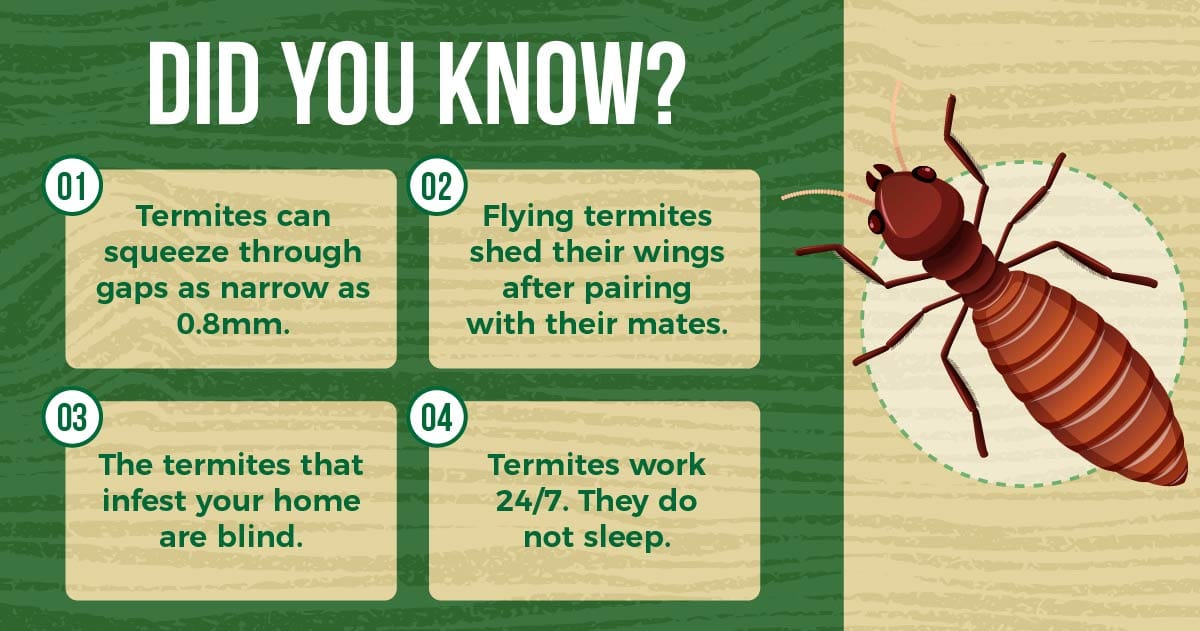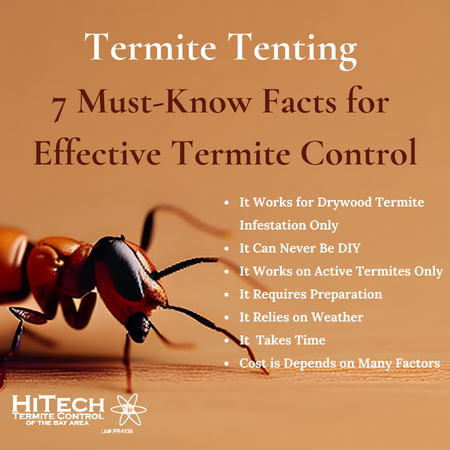Termites are silent destroyers that can wreak havoc on your home without you even realizing it. These tiny insects feed on wood, causing damage to the structure of your house and potentially costing you thousands of dollars in repairs.
Toc
To protect your home from these pests, it is essential to understand termite treatment methods and take necessary precautions. In this guide, we will cover everything you need to know about termite treatment so that you can safeguard your home from these destructive insects.
Introduction to Termite Treatment

There are several methods of termite treatment, and each one has its own advantages and disadvantages. Some common termite treatment options include:
- Liquid Termiticides: These are liquid chemicals that are applied to the soil around your home’s foundation or directly on wood structures to create a barrier against termites.
- Baiting Systems: Bait stations are placed around your property, and when termites feed on them, they carry the poison back to their colony, effectively eliminating it.
- Fumigation: This method involves sealing off your entire home and filling it with a gas that kills all the termites inside.
- Heat Treatment: By raising the temperature in your home to
The Importance of Termite Treatment for Homeowners
Termite infestations can cause significant damage to your home’s structure, leading to costly repairs and potential safety hazards. Regular termite treatment is essential for homeowners to protect their biggest investment and maintain its value.
Moreover, some states require termite inspections before selling a home, and a termite-free report can increase the value of your property.
Early Detection is Key
Recognizing the signs of a termite infestation early can save homeowners from extensive damage and expensive repairs. Look for subtle indicators such as mud tubes along your foundation walls, hollow-sounding wood, or discarded wings near windows and doors. Regular inspections, especially in spring when termites are most active, can help identify potential problems before they escalate.
In addition, homeowners should consider installing monitoring systems that can detect termite presence and alert them promptly. By remaining vigilant and proactive, you can protect your home from the destructive forces of termites and ensure its longevity.
Types of Termite Treatment

When it comes to protecting your home from termites, understanding the different types of treatment available is crucial. Below, we explore the various approaches in greater detail:
1. Liquid Termiticides
Liquid termiticides are one of the most common methods used for termite prevention and control. These chemical barriers create a protective zone around your home, making it difficult for termites to penetrate. They are typically applied to the soil around the foundation or to specific wooden structures to prevent infestations. The advantages of liquid termiticides include their effectiveness in stopping termites before they enter your home and their longevity, often lasting several years when properly applied. However, it is essential to hire a licensed pest control professional to ensure that the application is done correctly and safely.
2. Baiting Systems
Baiting systems offer a strategic approach to termite control by using bait stations placed around your property. These stations contain a slow-acting insecticide that termites consume and transport back to their colony, leading to the elimination of the entire colony over time. Baiting systems are advantageous because they are less intrusive than traditional liquid applications and can be monitored for effectiveness. Regular checks and replacements of the bait are necessary to ensure that they remain effective. This method is particularly suitable for environmentally-conscious homeowners as it minimizes chemical use around the home.
3. Fumigation
Fumigation is a comprehensive termite treatment method used for severe infestations. This process involves tenting the entire structure and filling it with a gas that penetrates all areas of the home, effectively exterminating termites. While highly effective, fumigation requires homeowners to vacate their property for a few days, plus it can be more costly than other methods. It is essential to consult with experienced pest control professionals to determine if your home requires this drastic approach and to ensure all safety measures are intermediately met.
4. Heat Treatment
Heat treatment is an eco-friendly alternative that involves raising the temperature of your home to a level that is lethal for termites, typically around 120°F to 140°F. This method is effective in penetrating wood and eliminating termites without the use of chemicals. It also has the added benefit of getting rid of other pests that may be lurking in your home. However, heat treatment requires bulky equipment and trained professionals to ensure even distribution of heat throughout the space. Homeowners should weigh the benefits against the cost and potential need for an alternative treatment for severe infestations.
Understanding the various types of termite treatments available is crucial for homeowners looking to protect their investment and maintain the integrity of their homes.
1. https://shoptonytoy.vn/archive/1424/
2. https://shoptonytoy.vn/archive/1448/
3. https://shoptonytoy.vn/archive/1441/
Signs of Termite Infestation

Identifying a termite infestation early is vital for effective treatment. Homeowners should be aware of various signs that indicate the presence of these pests. Common indicators include:
Mud Tubes
Mud tubes are a telltale sign of termite activity. These pencil-sized tubes are constructed from soil, wood, and saliva, and they provide termites with protection as they travel between their colony and food sources. Typically found along your foundation walls, on wooden beams, or in crawl spaces, these tubes can be a few inches thick and span several feet. If you notice any mud tubes, it’s essential to take action immediately, as their presence indicates a live infestation that needs to be addressed.
Hollow-Sounding Wood
Another critical indicator of a termite problem is hollow-sounding wood. Termites feed on the cellulose within the wood, often leaving just a thin veneer on the surface. Knocking on wooden surfaces can reveal a distinct hollow sound if termites have been active inside. Damage may not be visible at first glance, so it is important to conduct a thorough examination of wooden structures, particularly in areas known for termite activity.
Discarded Wings
Termites shed their wings after mating and establishing a new colony. If you find discarded wings near windows, doors, or other entry points, this can signal that a termite swarm has occurred nearby. The wings are usually transparent, and their presence should not be overlooked as it suggests that there may be an established colony within or near your home.
Frass
Frass, or termite droppings, is another sign of an infestation. These small, wood-colored pellets resemble grains of sand or sawdust and are usually found near wood structures that termites are consuming. The presence of frass indicates that termites are actively feeding inside wooden structures, and immediate action should be taken to investigate further and implement a treatment plan.
Regular inspections and awareness of these signs are key to early detection and effective control. Homeowners should stay vigilant, especially during peak seasons when termites are most active, to safeguard their homes against potential infestations. In addition, taking preventative measures such as removing wood-to-soil contact and fixing any water leaks can also help reduce the risk of termite problems in your home.
Different Types of Termite Treatment Methods
![]()
The most common types of termites found in homes are subterranean, drywood, and dampwood termites. Each type requires a specific treatment approach for effective control. Here’s an overview of the different methods used to treat each type:
Bait Systems: How They Work and Their Pros and Cons
Bait systems utilize a targeted approach to manage termite infestations by employing bait stations strategically placed around the property. These stations contain a slow-acting insecticide that is designed to be consumed by foraging termites. Once ingested, the termites return to their colony and share the bait with other members, leading to a gradual decline in the colony’s population.
Pros:
- Less Chemical Use: Bait systems generally use fewer chemicals compared to traditional treatments, making them more environmentally friendly.
- Monitoring Capability: Bait stations are easy to monitor for signs of activity, allowing homeowners to know when interventions are needed.
- Non-Intrusive: Unlike methods such as fumigation, bait systems do not require evacuating the home or significant disruptions.
Cons:
- Slow Action: Because the insecticide is slow-acting, it may take time to see a significant reduction in termite activity, which could be a concern for homeowners with severe infestations.
- Requires Regular Maintenance: To remain effective, bait systems need to be checked and replenished periodically, requiring ongoing attention and investment.
- Initial Cost: The setup and installation of a bait system can have a higher upfront cost compared to traditional treatments.
Overall, bait systems are an effective option for many homeowners, particularly for those looking to adopt a more eco-conscious approach to termite control. Understanding the advantages and disadvantages can help in making an informed decision about the best method for protecting your home from these destructive pests.
Liquid Termiticides: Application and Effectiveness
Liquid termiticides are one of the most traditional and widely used methods for managing termite infestations. These chemical solutions are applied to the soil around the foundation of a home, creating a barrier that prevents termites from entering. They are also used as a treatment for wood that is already infested, effectively killing the termites present.
Application Process:
The application of liquid termiticides typically involves trenching around the perimeter of the home’s foundation, where the liquid is then poured or injected into the soil. It’s critical that this process is performed by trained professionals to ensure proper coverage and effectiveness.
1. https://shoptonytoy.vn/archive/1424/
2. https://shoptonytoy.vn/archive/1440/
3. https://shoptonytoy.vn/archive/1465/
Effectiveness:
Liquid termiticides can provide immediate and long-lasting protection if applied correctly. Many formulations offer protection for several years, giving homeowners peace of mind. However, their effectiveness can diminish over time due to environmental factors such as rain or soil disturbance, which may lead to a need for reapplication.
Pros:
- Immediate Results: Liquid treatments can quickly eliminate active termite populations.
- Barrier Protection: A well-applied liquid termiticide provides ongoing protection against future infestations.
- Versatility: These treatments can be used both as a preventative measure and as a remedy for existing infestations.
Cons:
- Chemical Exposure: There may be concerns regarding chemical exposure for occupants and pets during and after application.
- Groundwater Contamination Risks: Improper application can lead to runoff or leaching, posing a risk to groundwater if not carefully managed.
- Evacuation Requirements: Depending on the product and application method, it may necessitate temporarily vacating the home.
Overall, liquid termiticides are an effective solution for many homeowners, especially when paired with ongoing monitoring to address any potential re-infestations. Understanding the specific needs and conditions of one’s home can guide the choice of termite treatment, ensuring comprehensive protection against these destructive pests.
Termite Barriers: Installation and Long-Term Protection
Termite barriers are preventative systems designed to block termites from entering a structure. There are two main types of barriers: physical barriers and chemical barriers.
Physical Barriers:
These include the use of materials like steel mesh, sand, or concrete to create a physical obstruction that termites cannot penetrate. The installation typically occurs during the construction of a new home or during significant renovations. It is essential to ensure that these barriers are continuous and cover all potential access points where termites could enter.
Chemical Barriers:
Chemical barriers involve the application of termiticides to the soil before the foundation is laid, creating a treated zone underground. This helps prevent subterranean termites from moving into the structure. Regular inspections and maintenance are vital, as environmental factors can compromise these barriers over time.
Long-Term Protection:
To maintain effective termite barriers, homeowners should perform annual inspections, focus on landscape management to reduce moisture, and avoid wood-to-soil contact. By implementing these measures, homeowners can significantly reduce the chances of termite infestations and safeguard their properties for years to come. Understanding the installation and maintenance of termite barriers is crucial for ensuring long-term protection against these destructive pests.
Conclusion
In summary, effective termite control requires a multifaceted approach that considers the various methods available — from bait systems and liquid termiticides to physical and chemical barriers. Each strategy has its own set of advantages and challenges, making it essential for homeowners to evaluate their unique circumstances, budgets, and preferences when choosing a treatment plan. Regular inspections and ongoing maintenance play a crucial role in safeguarding homes from future infestations, ultimately promoting a healthy and secure living environment. By arming themselves with the right information and resources, homeowners can take proactive measures to protect their properties from the threats posed by these destructive pests.












